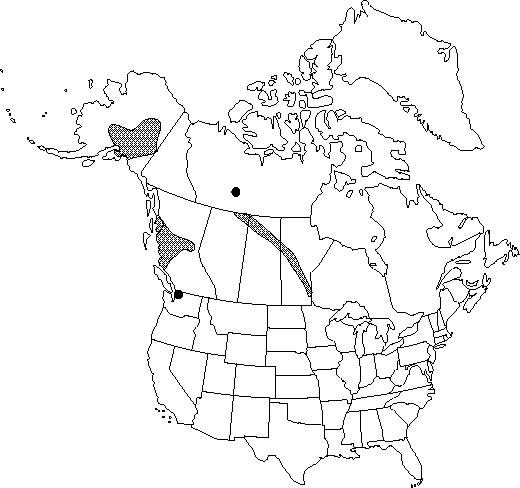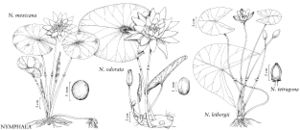Difference between revisions of "Nymphaea tetragona"
Bemerk. Reise Russ. Reich 1: 220. 1775.
FNA>Volume Importer |
imported>Volume Importer |
||
| (7 intermediate revisions by 2 users not shown) | |||
| Line 10: | Line 10: | ||
|special_status={{Treatment/ID/Special_status | |special_status={{Treatment/ID/Special_status | ||
|code=F | |code=F | ||
| − | |label= | + | |label=Illustrated |
}} | }} | ||
|basionyms= | |basionyms= | ||
| Line 21: | Line 21: | ||
}}<!-- | }}<!-- | ||
| − | --><span class="statement" id="st- | + | --><span class="statement" id="st-undefined" data-properties=""><b>Rhizomes </b>unbranched, erect, cylindric; stolons absent. <b>Leaves</b>: petiole glabrous. <b>Leaf</b> blade abaxially green to dull purple, adaxially green, sometimes mottled with reddish brown or purple, especially on young leaves, ovate to elliptic, 3-13(-14) × 2-11(-13) cm, margins entire; venation radiate centrally, without weblike pattern, principal veins 7-13; surfaces glabrous. <b>Flowers</b> floating, 3-7.5 cm diam., opening and closing diurnally, only sepals and outermost (occasionally innermost) petals in distinct whorls of 4; sepals uniformly green, obscurely veined, lines of insertion on receptacle very prominent, protuberant, forming tetragons; petals 10-17, white; stamens 30-70, yellow-orange, abaxially usually suffused with purple, connective appendage projecting less than 0.2 mm beyond anther; filaments widest above middle, longer than anthers; pistil 5-10-locular, appendages at margin of stigmatic disk boat-shaped, (2-)3-4 × 2-4 mm. <b>Seeds</b> ovoid, ca. 2-3 × 1.5-2 mm, ca. 1.3-1.5 times as long as broad, lacking papillae on surface. <b>2n</b> = 112.</span><!-- |
-->{{Treatment/Body | -->{{Treatment/Body | ||
| Line 27: | Line 27: | ||
|habitat=Ponds, lakes, and quiet streams | |habitat=Ponds, lakes, and quiet streams | ||
|elevation=0-1200 m | |elevation=0-1200 m | ||
| − | |distribution=Alta.;B.C.;Man.;N.W.T.;Sask.;Alaska;Wash.;Eurasia | + | |distribution=Alta.;B.C.;Man.;N.W.T.;Sask.;Alaska;Wash.;Eurasia. |
| − | |discussion=<p>Although broadly distributed in the northwest part of the flora, Nymphaea tetragona is apparently not common over the Canadian portion of its range. It was collected once in extreme northwestern Washington but is believed to be extirpated there. True N. tetragona is absent from northeastern North America and, now, from the conterminous United States, where this name has usually been applied to what is here segregated as N. leibergii. In size and shape of leaves and flowers the two taxa are very similar. They differ in the leaf mottling often present in developing leaves of N. tetragona but absent in N. leibergii; the distinctly tetragonal appearance of the receptacle in N. tetragona; and in the longer carpellary appendages, the presence usually of more stamens, and purple-colored stamens and pistils in N. tetragona. Only in living plants is it apparent that leaves of N. leibergii are thicker with impressed veins abaxially compared to the relatively thin leaves with raised veins in N. tetragona. Although distinctions in sepal and petal apices (often acute in N. tetragona and often rounded in N. leibergii) were the basis for the establishment of Castalia leibergii, the characters are variable in both taxa and thus of limited utility in distinguishing them.</p> | + | |discussion=<p>Although broadly distributed in the northwest part of the flora, <i>Nymphaea tetragona</i> is apparently not common over the Canadian portion of its range. It was collected once in extreme northwestern Washington but is believed to be extirpated there. True <i>N. tetragona</i> is absent from northeastern North America and, now, from the conterminous United States, where this name has usually been applied to what is here segregated as <i>N. leibergii</i>. In size and shape of leaves and flowers the two taxa are very similar. They differ in the leaf mottling often present in developing leaves of <i>N. tetragona</i> but absent in <i>N. leibergii</i>; the distinctly tetragonal appearance of the receptacle in <i>N. tetragona</i>; and in the longer carpellary appendages, the presence usually of more stamens, and purple-colored stamens and pistils in <i>N. tetragona</i>. Only in living plants is it apparent that leaves of <i>N. leibergii</i> are thicker with impressed veins abaxially compared to the relatively thin leaves with raised veins in <i>N. tetragona</i>. Although distinctions in sepal and petal apices (often acute in <i>N. tetragona</i> and often rounded in <i>N. leibergii</i>) were the basis for the establishment of Castalia leibergii, the characters are variable in both taxa and thus of limited utility in distinguishing them.</p> |
|tables= | |tables= | ||
|references= | |references= | ||
| Line 37: | Line 37: | ||
-->{{#Taxon: | -->{{#Taxon: | ||
name=Nymphaea tetragona | name=Nymphaea tetragona | ||
| − | |||
|authority=Georgi | |authority=Georgi | ||
|rank=species | |rank=species | ||
| Line 47: | Line 46: | ||
|habitat=Ponds, lakes, and quiet streams | |habitat=Ponds, lakes, and quiet streams | ||
|elevation=0-1200 m | |elevation=0-1200 m | ||
| − | |distribution=Alta.;B.C.;Man.;N.W.T.;Sask.;Alaska;Wash.;Eurasia | + | |distribution=Alta.;B.C.;Man.;N.W.T.;Sask.;Alaska;Wash.;Eurasia. |
|reference=None | |reference=None | ||
|publication title=Bemerk. Reise Russ. Reich | |publication title=Bemerk. Reise Russ. Reich | ||
|publication year=1775 | |publication year=1775 | ||
| − | |special status= | + | |special status=Illustrated |
| − | |source xml=https:// | + | |source xml=https://bitbucket.org/aafc-mbb/fna-data-curation/src/2e0870ddd59836b60bcf96646a41e87ea5a5943a/coarse_grained_fna_xml/V3/V3_529.xml |
|genus=Nymphaea | |genus=Nymphaea | ||
|species=Nymphaea tetragona | |species=Nymphaea tetragona | ||
| − | |||
| − | |||
| − | |||
| − | |||
| − | |||
| − | |||
| − | |||
| − | |||
| − | |||
| − | |||
| − | |||
| − | |||
| − | |||
| − | |||
| − | |||
| − | |||
| − | |||
| − | |||
| − | |||
| − | |||
| − | |||
| − | |||
| − | |||
| − | |||
| − | |||
| − | |||
| − | |||
| − | |||
| − | |||
| − | |||
| − | |||
| − | |||
| − | |||
| − | |||
| − | |||
| − | |||
| − | |||
| − | |||
| − | |||
| − | |||
| − | |||
| − | |||
| − | |||
| − | |||
| − | |||
}}<!-- | }}<!-- | ||
-->[[Category:Treatment]][[Category:Nymphaea]] | -->[[Category:Treatment]][[Category:Nymphaea]] | ||
Latest revision as of 22:49, 5 November 2020
Rhizomes unbranched, erect, cylindric; stolons absent. Leaves: petiole glabrous. Leaf blade abaxially green to dull purple, adaxially green, sometimes mottled with reddish brown or purple, especially on young leaves, ovate to elliptic, 3-13(-14) × 2-11(-13) cm, margins entire; venation radiate centrally, without weblike pattern, principal veins 7-13; surfaces glabrous. Flowers floating, 3-7.5 cm diam., opening and closing diurnally, only sepals and outermost (occasionally innermost) petals in distinct whorls of 4; sepals uniformly green, obscurely veined, lines of insertion on receptacle very prominent, protuberant, forming tetragons; petals 10-17, white; stamens 30-70, yellow-orange, abaxially usually suffused with purple, connective appendage projecting less than 0.2 mm beyond anther; filaments widest above middle, longer than anthers; pistil 5-10-locular, appendages at margin of stigmatic disk boat-shaped, (2-)3-4 × 2-4 mm. Seeds ovoid, ca. 2-3 × 1.5-2 mm, ca. 1.3-1.5 times as long as broad, lacking papillae on surface. 2n = 112.
Phenology: Flowering summer.
Habitat: Ponds, lakes, and quiet streams
Elevation: 0-1200 m
Distribution

Alta., B.C., Man., N.W.T., Sask., Alaska, Wash., Eurasia.
Discussion
Although broadly distributed in the northwest part of the flora, Nymphaea tetragona is apparently not common over the Canadian portion of its range. It was collected once in extreme northwestern Washington but is believed to be extirpated there. True N. tetragona is absent from northeastern North America and, now, from the conterminous United States, where this name has usually been applied to what is here segregated as N. leibergii. In size and shape of leaves and flowers the two taxa are very similar. They differ in the leaf mottling often present in developing leaves of N. tetragona but absent in N. leibergii; the distinctly tetragonal appearance of the receptacle in N. tetragona; and in the longer carpellary appendages, the presence usually of more stamens, and purple-colored stamens and pistils in N. tetragona. Only in living plants is it apparent that leaves of N. leibergii are thicker with impressed veins abaxially compared to the relatively thin leaves with raised veins in N. tetragona. Although distinctions in sepal and petal apices (often acute in N. tetragona and often rounded in N. leibergii) were the basis for the establishment of Castalia leibergii, the characters are variable in both taxa and thus of limited utility in distinguishing them.
Selected References
None.
